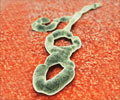
No medicine or vaccine exists.
Of around 1,850 people diagnosed with Ebola haemorrhagic fever since the virus was first identified 38 years ago in the Democratic Republic of Congo (then Zaire), 1,200 have died, the UN health agency says.
Experts say the virus, despite being extremely virulent, is containable because it kills its victims faster than it can spread to new ones.
The incubation period between exposure and the first symptoms varies from two to 21 days.
There are five species of the virus, of which three are particularly dangerous with fatality rates from 25 to 90 percent, according to the WHO.
Advertisement
The virus has been known to spread at burials where mourners touch the body, but doctors and nurses have also fallen ill after failing to take adequate precautions.
Advertisement
People have contracted the virus after handling infected chimpanzees, gorillas, monkeys, forest antelope and porcupines, dead or alive, in the Ivory Coast, Congo and Gabon.
Named after a small river in DR Congo, the virus killed 37 people in western Uganda in 2007 and at least 170 in the north of the country in 2000.
In a new outbreak, 59 people have died in the last six weeks in the southern forests of Guinea.
The only approach for the moment is to isolate patients and promptly bury the dead, said the WHO.
Hospital staff should use gloves, masks and goggles, and disinfect religiously.
"Several potential vaccines are being tested but it could be several years before any is available," says a WHO factsheet.
"A new drug therapy has shown some promise in laboratory studies and is currently being evaluated."
The virus’s natural reservoir animal, possibly the bat, is believed to reside in rain forests in Africa and areas of the Western Pacific.
Source-AFP










